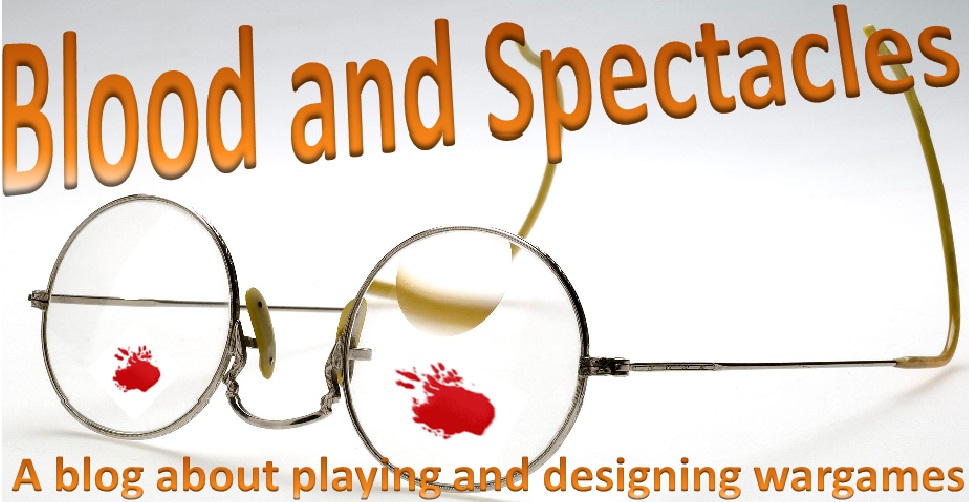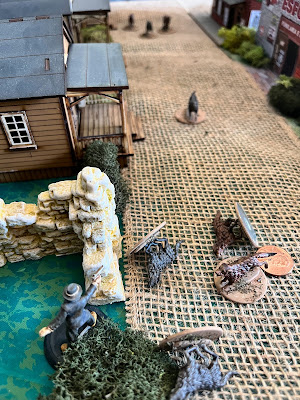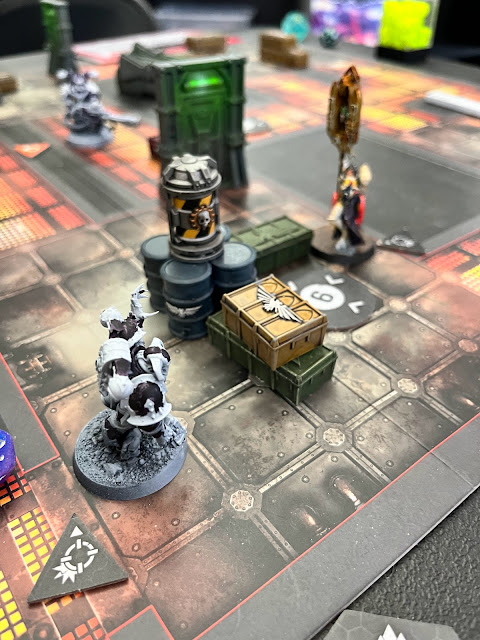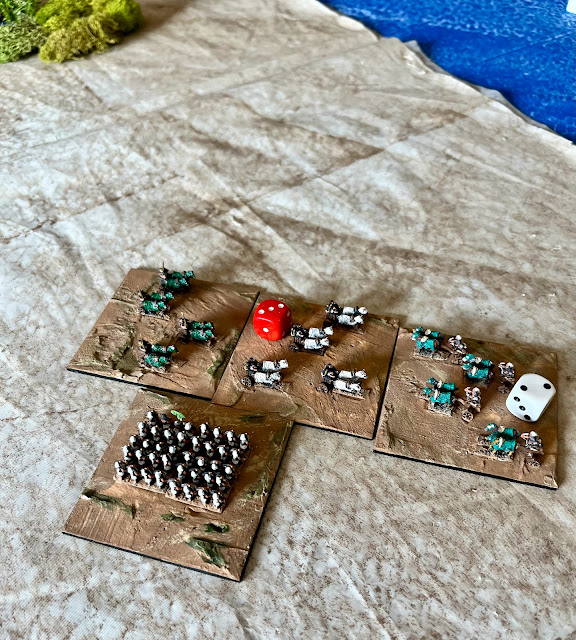I love B-movies, and I have for a long time. The hey-days of Golan Globus, Cannon Films, AIP, and many, many more. Now-a-days, they are much easier to track down and are often available for free. Streaming services are starving for content, and B-movies provide it in spades.
A famous B-movie schlockmaster, perhaps the infamous Roger Corman himself; had an old saying about a good B-movie. If I recall correctly, it went something like; "Give them the sizzle and the steak". Basically, he meant give the audience an interesting premise or titillating idea and then deliver on it. Give them a reason to keep watching, and deliver on what your premise leads to. If a movie was all sizzle and no steak, the film didn't deliver the goods. It was a weak film in his mind.
This saying came to mind when I was thinking about wargame design recently. I was thinking about what made an action scene in a film compelling, what made a combat scene in an RPG exciting, and therefore what made a wargame interesting to play. Through this thinking, reading, researching, and analysis I came to one conclusion; Stakes.
What are the Stakes
Put simply, the stakes of a fight are why the fight is happening in the first place. People generally do not engage in physical battle just for the luls. It hurts and is painful. The risks are high. They fight for a reason. Clausewitz said, "War is the continuation of politics by another means" or something to that effect.
Stakes are essentially, what bad things happen if your side loses. Of course, for individual soldiers it can be life or death. The Stakes are very personal. However, reading historical accounts, watching soldier interviews, and talking to soldiers; those stakes are not why they are fighting. So when we talk about the stakes, survival is one of them; but not the most compelling one. Survival is a baseline.
Take RPGs as an example. Some players feel like a character potentially dying is the "highest" level of stakes. However, having played many RPGs myself, survival is never the goal. That is a baseline for completing your objectives or avoiding the stakes. Life and death in a wargame is not an interesting stake either, that is the baseline threshold to achieve your actual objectives.
The true stakes are the consequences if you fail. In real-historical terms the stakes are often who is the victor and who is the spoils. In a stories and film, it is if the protagonist gets to continue complete their character arc or fulfill the larger plot points. In RPG, it mirrors stories; but is focused on the group completing their quest or your character evolving over time.
So, what are the stakes in a wargame? This is much harder to discern. Battles are one-off affairs. Their is a winner and a loser. Is that the stakes of a wargame? Is that it?
Is Winning a Compelling Enough Stake
Winning and losing are not compelling stakes for prolonged replayability. Winning eventually gets boring if you think the game is solved. There needs to be something more, or why keep coming back to the game?
Winning is a baseline for accomplishing a players larger objectives. That might be to "Get Gud", gain social status with their group, or some other personal reason. However, winning by itself is not a long-term compelling reason to play any game. Eventually, games that only focus on winning will get shelved.
There are two ways wargamers themselves try to deal with creating stakes for themselves:
1. They create a community
2. They play campaigns
Both of these options create tangible and intangible benefits for winning and losing any single game. Communities do this by creating a shared social experience of camaraderie and (hopefully) friendly competition. This is often expressed in the form of a Tournament, but can also be shown with shared experiences and story-telling.
Campaigns give direct consequences and rewards for playing. Benefits that carry-over to the next game or consequences that happen. These are tangible rewards. The intangible rewards are opening up new scenarios or moving a storyline forward. All create Stakes for winning or losing in any given game.
You can even do both options!
The Designers Role in Making Stakes
As designers, we know that the two ways to build Stakes into your game, and help create replayability ; follows two paths. Therefore, you can incorporate these paths into your game. As a designer, you can provide the tools and rules the players themselves will need to create a community or a campaign.
I would argue that these rules are not Chrome. They are essential to creating a fully rounded game experience. A game where the only stakes are winning and losing will soon be shelved and fall out of favor.
In addition, making these part of your core rules allows for you to showcase the soul of your game. This can be done for any scale game, any time period, any genre. A lot of the flavor and feel for your game can be expanded upon and mined creating the setting or intended gameplay experience. It should suggest ideas for the community to grab onto for discussion, storylines for campaigns, and add depth to the world the players are engaging in. By doing so, players now have the tools to make their own stakes for the game beyond winning and losing. Now, they own part of the game world too.
Final Thoughts
Wargames as a stand alone battle often have no stakes. Games without stakes will soon fall by the wayside and no longer drive player interest. For longevity and replayability, designers need to add elements for community building and campaigns into the core rules of the game in order to create stakes. Games with stakes are more compelling and interesting to play, and will therefore be more usable by the players.
Bonus Content
We are getting to the end of Turn 1 of the campaign, and the forces of Chaos are surging across Powellington.
The corruption has struck deep into the city, so deep that the Cathedral of St. Augustine in the Arcopolis was under threat! Chaos forces attempted to breach the holy shrine by accessing maintenance tunnels beneath the Arcopolis. The Order of St. Augustine Martyred mobilized scouting forces to go down into the underbelly of the Cathedral and deal with this sinister threat.
My Sisters of Battle were finally tapped to take action in the campaign as I was paired up with a Chaos opponent this week, Black Legionaries. This would be a tough battle, as we also had an unusual board. It was a board from the old first edition of Kill Team that took place inside of an enclosed area. It was designed for tourneys, and essentially was a mirror match board. Interesting and all news to me!
The Heavy Bolter sister held down the right flank, and was the hero of the match. She accounted for 3 of the 4 Chaos kills. My left flank completely collapsed as the Chaos Possessed broke loose and the demon rampaged through the Sisters stationed there. The interior buildings made it hard to spread out enough to avoid getting multiple Sisters in combat with the beast at once!
In the center, there was a stand-off between the Chaos Heavy Gunner and a Melta Sister. No one wanted to open the door separating them. This allows the Sister Superior to rush ahead and grab some objectives deep in Chaos territory. However, in the end it was too little and too late to stop the forces of Chaos.
This was a challenging board for my girls to play on. Their Bolt guns range did not help them too much, compared to the Legionnaires who were mostly tooled for up-close work. In addition, the 3 APL for the Chaos forces had them move into position really quickly. However, the Emperor's Guidance was very useful to me as was the Icon. The relatively simple Compendium rules worked well for this old man's brain! I think the ladies held their own, and a few even survived!
The end of Turn 4 saw the Sisters left collapse and allowed the Chaos troops to secure and defend a key objective marker. One more Turning Point, and I probably would have killed all the Legionaries but I still would have lost on Objective Markers. They got there the quickest with the mostest this time.
Chaos forces won across the board on this True Crit Gaming Guild day. The forces of Chaos look like they will be ending Turn 1 with a lead in all warzones.
Until next time!
Become a Patron and get access to all the cool stuff, a peak behind the curtain of Blood and Spectacles, and early-access to playtest games!
Check out the latest publications and contact me at our
Blood and Spectacles Website
Or purchase all out games at the Blood and Spectacles Publishing Wargames Vault Page!
Posted by Blood and Spectacles Publishing at 1:59 AM















































